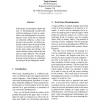Free Online Productivity Tools
i2Speak
i2Symbol
i2OCR
iTex2Img
iWeb2Print
iWeb2Shot
i2Type
iPdf2Split
iPdf2Merge
i2Bopomofo
i2Arabic
i2Style
i2Image
i2PDF
iLatex2Rtf
Sci2ools
ACL
2001
2001
Statistical Corpus-Based Word Sense Disambiguation: Pseudowords vs. Real Ambiguous Words
In this paper we investigate whether the task of disambiguating pseudowords (artificial ambiguous words) is comparable to the disambiguation of real ambiguous words. Since the two methods are inherently different, a direct comparison is not possible. An indirect approach is taken where the setup for both systems is as similar as possible, i.e. using the same corpus and settings. The results obtained clearly indicate that the tasks are quite different. We conclude that the current practice of using pseudowords cannot be taken as a substitute for testing with real ambiguous words.
| Added | 31 Oct 2010 |
| Updated | 31 Oct 2010 |
| Type | Conference |
| Year | 2001 |
| Where | ACL |
| Authors | Tanja Gaustad |
Comments (0)

